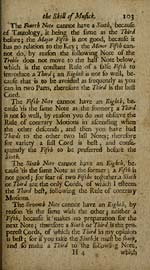Inglis Collection of printed music > Printed text > Introduction to the skill of musick, in three books
(126) Page 102
Download files
Complete book:
Individual page:
Thumbnail gallery: Grid view | List view

i ox An Introduction to
Oblervc this always in Counterpoint, to avoid
Tautology in letting a Baft to a Trehle, and let
it be as Formal and Airy as the Treble will a<jl- ,
mit.
Let us a little examine this laft Example.,
And now fuppofing there were ho Bafs to the*
Treble, try Note by Note which is the properefl
Cord to each.
For the Fir ft Note y you inuft certainly have*
an Eighth, becaufe it relates to the Key it isf
compoled in.
For the Second, you have only two Cords toj
chufe, viz,, the Sixth, and Third ; the Fjth you?;
mult not ufe, becaufe 'tis expe&ed to the Note,
following to make a Third, therefore to bel
avoided , left you are guilty of that Tautology;
before-mentioned, and befides there is not that
Form and Variety which is required in fevy"
Parts j and an Eighth you cannot ufe neither,
becaule you run either into the Error of twJ|
Eighths together if you afcenjd, or of cloying" j
the Ear with too many Fcrfeft 'Cords if you de-
fcendj therefore the Third or Sixth is the only '
Cords you can ufe ; of thefe, the Sixth is much
the ben, for two Reafbns: Firft, you move by i
contrary Motion to the Bafs, which is an Ele-
gancy in two Parts ; in the next place, you in-
^iFpduce the next Note more Harmonically with
the Sixth than you can with the Third, but the
" Sixth mu{\ bzjh.irp, becaufe it has a nearer affi-
nity to the Key.
The T has a Third, which is generally
the conference of a Sixth.
The j
Oblervc this always in Counterpoint, to avoid
Tautology in letting a Baft to a Trehle, and let
it be as Formal and Airy as the Treble will a<jl- ,
mit.
Let us a little examine this laft Example.,
And now fuppofing there were ho Bafs to the*
Treble, try Note by Note which is the properefl
Cord to each.
For the Fir ft Note y you inuft certainly have*
an Eighth, becaufe it relates to the Key it isf
compoled in.
For the Second, you have only two Cords toj
chufe, viz,, the Sixth, and Third ; the Fjth you?;
mult not ufe, becaufe 'tis expe&ed to the Note,
following to make a Third, therefore to bel
avoided , left you are guilty of that Tautology;
before-mentioned, and befides there is not that
Form and Variety which is required in fevy"
Parts j and an Eighth you cannot ufe neither,
becaule you run either into the Error of twJ|
Eighths together if you afcenjd, or of cloying" j
the Ear with too many Fcrfeft 'Cords if you de-
fcendj therefore the Third or Sixth is the only '
Cords you can ufe ; of thefe, the Sixth is much
the ben, for two Reafbns: Firft, you move by i
contrary Motion to the Bafs, which is an Ele-
gancy in two Parts ; in the next place, you in-
^iFpduce the next Note more Harmonically with
the Sixth than you can with the Third, but the
" Sixth mu{\ bzjh.irp, becaufe it has a nearer affi-
nity to the Key.
The T has a Third, which is generally
the conference of a Sixth.
The j
Set display mode to: Large image | Transcription
Images and transcriptions on this page, including medium image downloads, may be used under the Creative Commons Attribution 4.0 International Licence unless otherwise stated. ![]()
| Special collections of printed music > Inglis Collection of printed music > Printed text > Introduction to the skill of musick, in three books > (126) Page 102 |
|---|
| Permanent URL | https://digital.nls.uk/94574764 |
|---|
| Description | Scottish and English songs, military music and keyboard music of the 18th and 19th centuries. These items are from the collection of Alexander Wood Inglis of Glencorse (1854 to 1929). Also includes a few manuscripts, some treatises and other books on the subject. |
|---|
| Description | The Glen Collection and the Inglis Collection represent mainly 18th and 19th century Scottish music, including Scottish songs. The collections of Berlioz and Verdi collected by bibliographer Cecil Hopkinson contain contemporary and later editions of the works of the two composers Berlioz and Verdi. |
|---|

